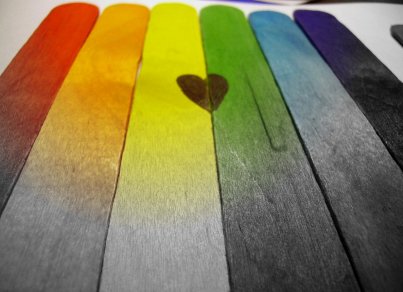This post is a result of one of those moments when a question suddenly pops in your mind out of nowhere. Have you ever wondered about this calamity? Perhaps when a favourite bright red t-shirt becomes a dreary remnant of its vibrant past? Well, maybe you should dry it inside out.
Anybody who has studied science in high school will be able to answer this question reasonably well. But if you haven’t, continue reading.
To answer this question is not a very simple task, and neither is it rocket science. I’m going to be very colloquial, because I’m trying to explain a simple phenomenon to a person with minimum scientific inclinations. And I’ll refrain from using scientific terminology as much as I can.
First of all, what is colour? Why do you call something purple and some other thing blue? Let’s tackle this first. The white light from the sun is not just one white colour. It is a bunch of different colours, each identified by a different frequency, or energy. The rainbow is basically the sun’s light split into different colours. Now when this white light (which can be sourced from your light bulbs too) falls on different objects, the constituent particles of that object absorb certain colours and reflect the rest back. Whatever is reflected back is what we see.
I’ll explain. Say for example you have 2 green and two red balls, and you throw all four towards your friend. He puts the green ones in his pocket because he needs them and throws the red ones to another person. This last person only gets red balls, and that’s all what he sees. Similarly leaves have some substances in them which absorb red part of the white light, and reflect green back. This green is what we see as the colour of our leaves, which also happens to be my favourite colour.
Now we know what colour is. Wait, if sunlight is the source of colours, why does it fade colours? The answer is simple, there’s more to sunlight than meets the eye, literally. There are certain frequencies (or colours) which our eyes cannot see. Sorry, that’s the truth. Maybe evolution will help you out. You must have heard of UV or Ultraviolet Rays. These rays are harmful to a lot of things, dyes included. So, all your water-colours, dyes and ink will fade in the sun. There are, although, certain colouring substances that do not fade.
What UV rays do is they break those substances which cause colour. The chemicals that make dyes will react with UV rays and will deteriorate, rendering the colours lifeless. This process is called Photodegeneration.
So, any random simple questions popping in my brain will be put up like so. Tell me if you’ve gained anything, or if this is a total waste of time. Questions will be answered. More such posts to come in the future!

Thank you for writing this. I’ve wondered what causes colors to fade and even though I guessed it had something to do with UV radiation I didn’t understand the process or know it had a name.
LikeLike
Thank you for reading it! It’s good to know someone gained from it 🙂
LikeLiked by 1 person
You’re welcome 🙂
LikeLike
Never thought the detail behind the simple play, well explained.
Well that makes me wonder does the same applies on Northern Lights? Cheer!
LikeLike
Hey Arun.. Thanks 🙂 and you gave me a nice idea for a future post..!
LikeLike
Are UV rays the primary reason for fading colours of my t shirt. Some say colour fade due to rough wash
LikeLike
of course they’re not the primary reason, but it does help.
LikeLike
Woww Vishakha 😱
Such basic phenomenon I must have read it in my early school but couldn’t recall.
Thanks for putting it in such a simple manner with that ‘easy to relate to’ example.
Looking forward to learning more from this page.
Keep it up!
LikeLike